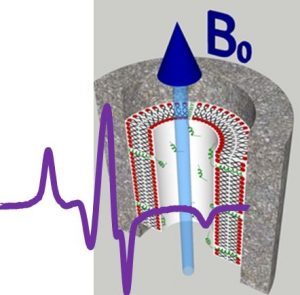Research
Research activities in the Prof. Smirnov lab are concentrated in three principal areas:
1) lipid nanotube arrays for protein biochips and hybrid nanoscale devices
2) fundamental roles of intermolecular interactions in self-assembly and structure-function relationships of membrane proteins
3) coupled spin systems and spin coherence in nanostructures and information devices that are based on quantum principles
 1) Lipid Nanotube Arrays
1) Lipid Nanotube Arrays
Prof. Smirnov group at NC State University is taking on an alternative approach to building substrate-supported lipid bilayers and protein biochips. Our methodology is based on the property of phospholipids to self-assemble inside the nanopores into cylindrical structures we discovered recently. We have already confirmed the existence of these structures, which we call lipid nanotubes, with spin labeling Electron Paramagnetic Resonance (EPR) and 31P NMR. Specifically, we determined that when supported by well-aligned through-film rigid nanopores of Anodic Aluminum Oxide (AAO) substrate, these lipid nanotubes exhibit an exceptionally high degree of static order while the other local properties are remarkably similar to those of unsupported membrane vesicles. Currently, we are utilizing our substrate-supported lipid nanotube technology to develop a new generation of robust and efficient hybrid nanoscale devices. Specifically, using variety of spectroscopic approaches, we are characterizing binding of proteins to lipid nanotubes and optimizing conditions for patterned deposition of lipids and proteins onto nanoporous substrates.
2) Intermolecular Interactions in Self-Assembly of Membrane Proteins
Electrostatic interactions and hydrogen bonding play fundamental roles in protein folding and assembly of proteins in membranes. Despite their fundamental importance, local electrostatic interactions in proteins and membranes remain to be very elusive parameters because of the scarcity of the experimental methods that can be used to measure these effects accurately and unambiguously. In our lab we are using high resolution high field EPR (HF EPR) and site-specific labeling of biopolymers to map these interactions and protein side-chain dynamics on atomic level. Currently, using HF EPR, which has a sub-picomolar quantity protein/peptide requirement, we are mapping local polarity and peptide-membrane interaction for a series of short model peptides and spin-labeled proteins in order to derive the relationship between local electrostatic and structural conformation of biopolymers. The next phase of this work will be focused on studies of electrostatics and molecular mechanisms of interactions of viral peptides and drugs with lipid bilayers.
3) Spin Coherence in Nanostructures and Quantum Information Devices
Electrical characterization of quantum confinement and spin coherence in nanostructures is primarily an unchartered area of research and that requires state-of-the-art combination of cryogenic temperatures, high magnetic fields, and mm-wave low noise techniques. In collaboration with Profs. Misra, Wook, and Holton (Electrical & Computer Eng., NC State University), who are designing and manufacturing quantum dot arrays of a pure silicon design where the electron is trapped at the Si to SiO2 interface beneath a metal electrode., our laboratory is engaged in developing of specialized EPR technology to characterize and to manipulate quantum properties of the electronic spins at cryogenic temperatures.
